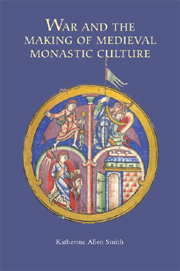Book contents
- Frontmatter
- Contents
- Dedication
- Acknowledgments
- List of Abbreviations
- Introduction
- 1 Encountering War in the Scriptures and Liturgy
- 2 Monks and Warriors: Negotiating Boundaries
- 3 Spiritual Warfare: The History of an Idea to c.1200
- 4 Martial Imagery in Monastic Texts
- 5 Warriors as Spiritual Exemplars
- Conclusion
- Appendix: The Loricati, c.1050–1250
- Bibliography
- Index
- Title in the Series
Conclusion
Published online by Cambridge University Press: 05 February 2013
- Frontmatter
- Contents
- Dedication
- Acknowledgments
- List of Abbreviations
- Introduction
- 1 Encountering War in the Scriptures and Liturgy
- 2 Monks and Warriors: Negotiating Boundaries
- 3 Spiritual Warfare: The History of an Idea to c.1200
- 4 Martial Imagery in Monastic Texts
- 5 Warriors as Spiritual Exemplars
- Conclusion
- Appendix: The Loricati, c.1050–1250
- Bibliography
- Index
- Title in the Series
Summary
Within the history of Christianity's long, vexed relationship with war, monastic communities have been assumed to have had little to do with warfare either conceptually or in practice. The main contention of this study, that monastic identity was negotiated through direct, constant confrontations with war and warriors, has challenged the traditional exclusion of professed religious from this historical narrative. In so doing, it has aimed to undermine one of the central divisions historians have traditionally emphasized in their reconstruction of the medieval past: the ideological separation of peace-loving religious communities from bloodthirsty knights, of ‘those who prayed’ from ‘those who fought.’ To be sure, recent scholarship focused on the piety and patronage of medieval elites has forced a re-evaluation of the first of these stereotypes, while studies of churchmen's role in defining and mediating just and unjust wars have challenged the second. But if it has been accepted that, at least to some degree, clerics taught warriors how to think and act as christians, the possibility that churchmen in turn learned from lay warriors ought also to be considered. Armsbearers' conceptions of sin, penance, and salvation were mediated by their relationships with religious institutions, and these contacts left their imprint on those living within the monastery as well. Monastic identity was constructed not simply in opposition to, but in dialogue with warriors, especially during the eleventh and twelfth centuries, against the backdrop of monastic reform and the early crusading movement.
- Type
- Chapter
- Information
- War and the Making of Medieval Monastic Culture , pp. 197 - 200Publisher: Boydell & BrewerPrint publication year: 2011



